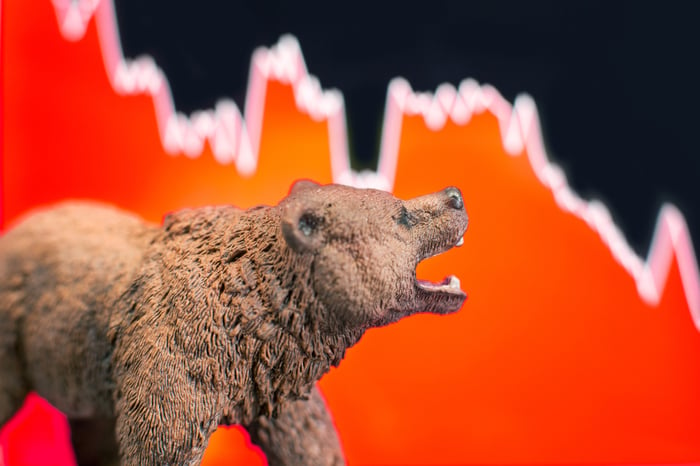Whether you realize it or not, investors have witnessed history being made in 2020. They've seen the longest bull market in history (11 years) come to an unceremonious end because of the coronavirus disease 2019 (COVID-19) pandemic, and were taken for one heck of a ride when it took just 17 trading sessions for the market to move from all-time high levels into bear market territory. That's by far the steepest descent into a bear market in history.
Investors have also been privy to record-setting volatility, as measured by the CBOE Volatility Index, or VIX. The benchmark S&P 500 (^GSPC 1.81%) has logged 10 of Its 13-largest single-session point declines in history since Feb. 24, 2020, as well as its eight-biggest single-day point gains ever.
With the stock market falling in excess of 30% in just over a month, and now having bounced back nearly 30% from its lows set on March 23, the question investors are left to ask is this: Is a stock market bottom now in?

Image source: Getty Images.
While the fact remains that no one knows this answer with any certainty, I'm willing to publicly state that, no, I don't believe a stock market bottom has been reached yet. Though I make no prognostications as to how low the market can go, or how long it would take to effectively reach a bottom, I do have five reasons why I believe the worst is yet to come.
1. We still know very little about COVID-19
Let's start with the basics. Namely, we still don't know a whole lot about the novel coronavirus that's spread to more than 1.9 million worldwide, according to Johns Hopkins University. Although we're learning firsthand how important social distancing measures are, researchers still don't have a concrete treatment option in place (though many are being tested), or an antiviral vaccine, of which many are being studied.
Researchers are also unsure if SARS-CoV-2, the virus behind COVID-19, will retreat during warmer months like most other viruses or if it'll persist throughout the summer and fall.
Since there is no precedent to this disease, nor to the global response in the wake of this pandemic, there's uncertainty as to when the U.S. and global economies will get back to normal. This uncertainty is bound to adversely affect consumer spending habits and will surely weigh on the operating results of publicly traded companies.
Until we know a lot more about COVID-19, I struggle to see how the stock market can advance higher.

Image source: Getty Images.
2. Earnings are going to be atrocious in Q1, Q2, and maybe even Q3
This probably goes without saying, but operating results for the first, second, and perhaps even third quarter are going to be ugly, with a capital "U." According to FactSet Research Systems' "Earnings Insight" report for S&P 500 companies, the estimated earnings decline for the broad-based index in Q1 2020 is 10%. By comparison, FactSet had expected earnings growth of 4.3% for Q1 2020 when the year began.
For the broader economy, things are even grimmer. Investment bank Goldman Sachs has forecast a 34% contraction in second quarter real gross domestic product (GDP), with JPMorgan Chase taking the "optimistic" approach among big banks with a call for "only" a 25% contraction in Q2 real GDP.
With nonessential businesses closed across much of the United States, and no definite timetable as to when they'll reopen, we're going to see jaw-dropping operating results that will test long-term investors' resolve and likely trigger emotional short-term traders to act.

Image source: Getty Images.
3. For once, Wall Street prognostications are meaningless
Another reason I believe the stock market is destined to break through its March 23 low is because it doesn't have Wall Street setting the bar low enough for it to easily step over.
One consistency with the stock market (or at least S&P 500-listed companies) is that, in expanding or contracting economies, a majority of publicly traded companies tend to handily surpass Wall Street's per-share profit expectations. Having "beat" Wall Street's expectations tends to supersede whether that translates into actual year-on-year sales or earnings growth. All investors seems to care about is that publicly traded companies are outpacing Wall Street's expectations.
Right now, there are no consistent expectations from Wall Street. Most publicly traded companies have withdrawn their fiscal 2020 guidance, and in the process have left Wall Street with no bar to set for them to step over. Without this "earnings beat" confirmation bias, I expect earnings season to be a real dud for the market.

Image source: Getty Images.
4. A mortgage default wave is brewing
A fourth issue is that we appear to be on the cusp of another wave of mortgage defaults. While banks have temporarily forgiven late mortgage payments in some states, and relief packages are in place to help borrowers navigate this temporary disruption, at some point banks are going to have to recognize that their rock-solid loan portfolios are suddenly not so rock-solid.
The good news here is that big banks have much heftier equity positions than they did during the financial crisis, and they presumably have the federal government and Federal Reserve in their corner should things deteriorate.
However, with JPMorgan Chase tightening its lending standards for home loans this week, and other money-center banks almost certain to follow, we're witnessing what looks like the early stages of a mortgage default wave that'll sweep the country in the second half of 2020.

Image source: Getty Images.
5. The Fed is out of traditional firepower
Fifth and finally, the Federal Reserve is completely out of its traditional firepower.
The Fed is our nation's central bank, and its role is to influence monetary policy. The most conventional means of doing this is increasing or decreasing the federal funds rate -- i.e., the rate financial institutions charge each other for overnight borrowing. When the Fed wants to ensure the economy doesn't overheat, it'll raise the federal funds rate. Meanwhile, when it wants to boost the U.S. economy it'll lower the federal funds rate to encourage borrowing and lending.
Historically, it's taken an average of 500 basis points' worth of declines in the federal funds rate to pull the U.S. economy out of a recession. But the federal funds rate's high point in the latest 11-year expansion cycle was only a range of 2.25% to 2.5%. Thus, the Fed doesn't have the usual amount of conventional firepower at its disposal -- it's already cut 225 basis points, back to an all-time low of 0% to 0.25% -- and has, instead, turned to unlimited quantitative easing to try to support equities. While this has been good enough for a temporary boost in the stock market, it still doesn't guarantee that consumers will spend. And that's a problem when consumption accounts for 70% of U.S. GDP.
Once again, I don't know how far the stock market could fall or how long it'll take to get there, but I'm looking for the March 23 closing lows to be breached at some point in the future.




